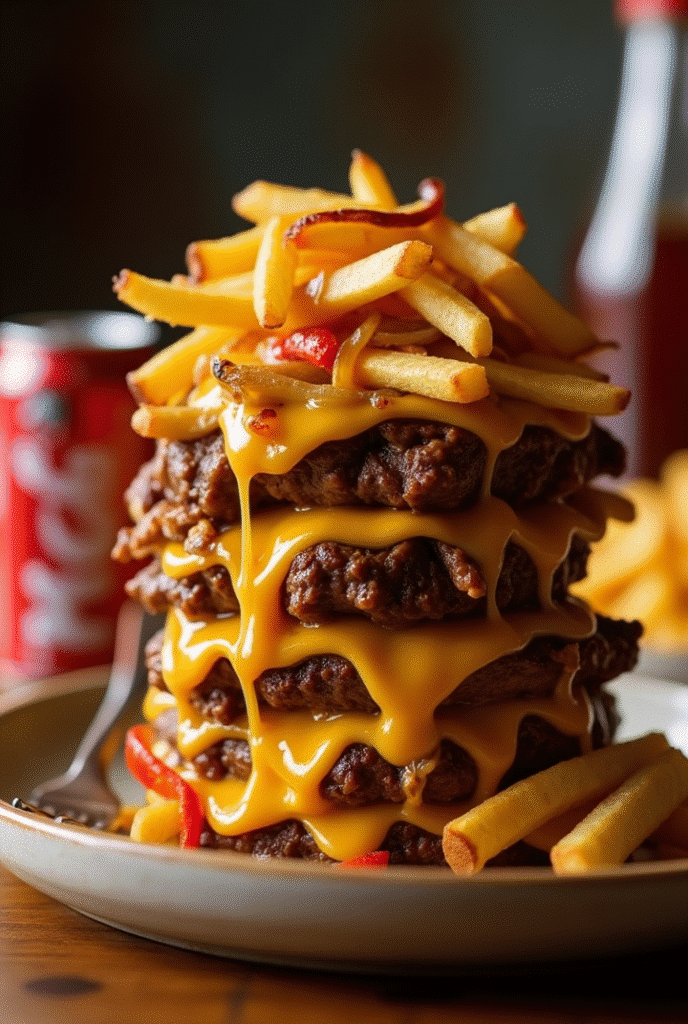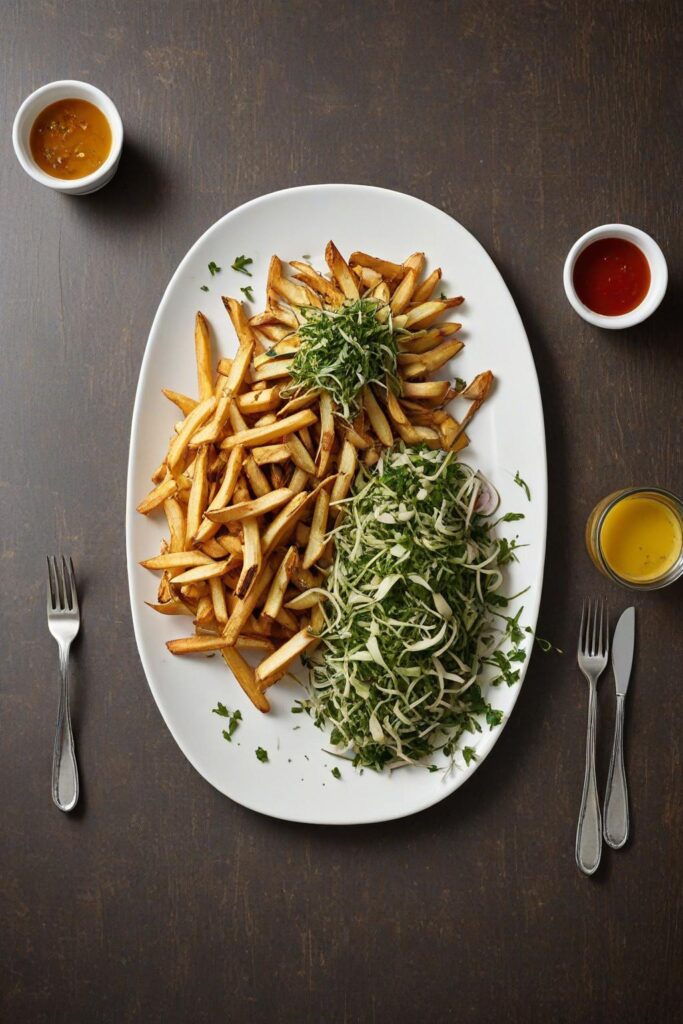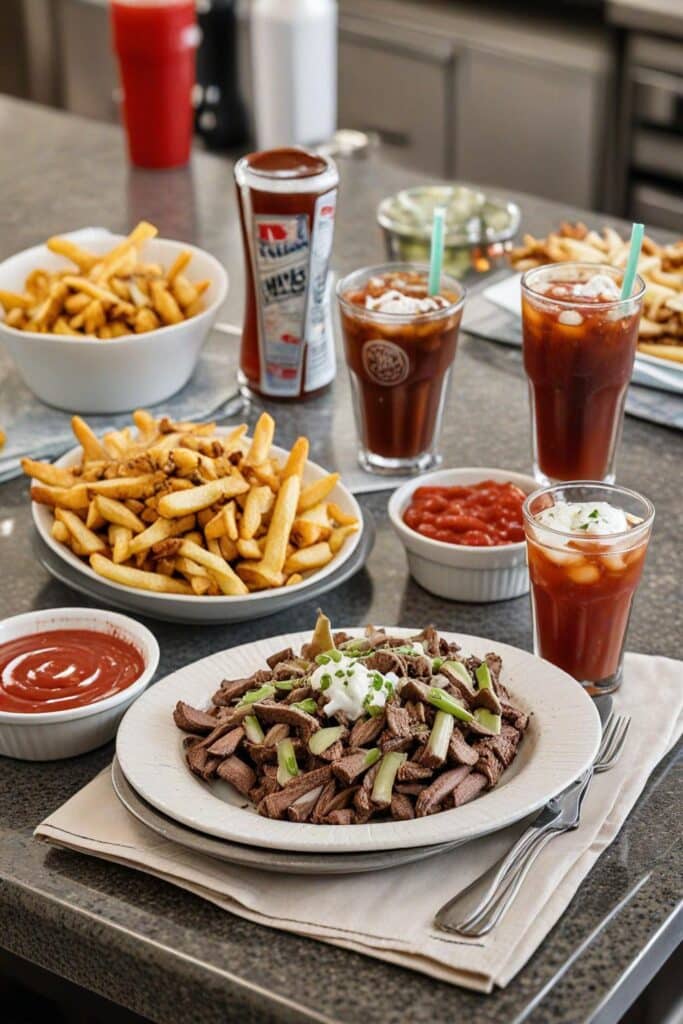I still remember the first time I had proper Philly steak cheese fries. It was after midnight at this little hole-in-the-wall joint in South Philly, where the grill had been seasoned by decades of use. The cook, a gruff man with forearms like tree trunks, slid a paper boat of fries across the counter that changed my culinary perspective forever. They wasn’t just food—they were a religious experience.
Philly steak cheese fries represent the beautiful marriage of two iconic American comfort foods: the legendary Philly cheesesteak and loaded french fries. This dish transcends simple street food status, combining thinly sliced ribeye, perfectly crisp fries, and gooey cheese into a harmonious creation that demands to be taken seriously. Its the ultimate indulgence that balances texture, flavor, and pure satisfaction in every bite.
1. Ingredients & Substitutions
For the Steak:
- 1 pound ribeye steak, partially frozen (essential for proper slicing)
- 2 tablespoons vegetable oil
- 1 medium yellow onion, thinly sliced
- 1 green bell pepper, thinly sliced
- 8 ounces white button mushrooms, sliced (optional)
- 2 cloves garlic, minced
- 1 tablespoon Worcestershire sauce
- 1 teaspoon kosher salt
- 1/2 teaspoon freshly ground black pepper
- 1/4 teaspoon dried oregano
Ribeye is traditional and preferred for its marbling and flavor, but you could substitute cheaper cuts like sirloin or flank steak in a pinch. Just be aware that leaner cuts can become tough if overcooked. Vegetarians can swap in seitan, portobello mushrooms, or even plant-based meat alternatives—though the texture will definitely be different.
For the Fries:
- 2 pounds russet potatoes (approximately 4 large potatoes)
- 2-3 cups peanut oil for frying (or vegetable oil)
- 1 teaspoon kosher salt
- 1/2 teaspoon garlic powder
- 1/4 teaspoon smoked paprika (optional)
Russets are your best bet for fries due to their high starch content, which yields that perfect crispy-outside, fluffy-inside texture we’re after. Yukon Golds can work in a pinch, offering a creamier interior but slightly less crisp exterior. For those avoiding deep frying, oven-baked fries can substitute, though the texture wont be identical.
For the Cheese Sauce:
- 2 tablespoons unsalted butter
- 2 tablespoons all-purpose flour
- 1 cup whole milk, warmed
- 8 ounces cheese (traditional options include Cheez Whiz, provolone, or American)
- 1/4 teaspoon mustard powder
- Pinch of cayenne pepper (optional)
- Salt and black pepper to taste
Many Philly purists swear by Cheez Whiz, but dont let that limit you. A combo of sharp white cheddar and American cheese creates an amazing smooth, melty sauce. For those avoiding dairy, cashew-based vegan cheese sauces can work surprisingly well, though they require different preparation techniques.
Optional Toppings:
- Jalapeños, pickled or fresh
- Bacon bits
- Scallions or chives, thinly sliced
- Hot sauce
- Ranch or blue cheese dressing drizzle
2. Step-by-Step Instructions

Preparing the Steak:
- Place the ribeye in the freezer for about 30 minutes to firm up—this makes it much easier to achieve those paper-thin slices that are the hallmark of a proper Philly cheesesteak. Remove and slice as thinly as possible against the grain. If your knife skills aint great, asking your butcher to slice it for you is a perfectly valid strategy.
- Heat 1 tablespoon of oil in a large cast iron skillet or flat top griddle over medium-high heat until shimmering. Add the onions and bell peppers, cooking until they begin to soften and caramelize at the edges, about 5-7 minutes. Add the mushrooms (if using) and cook for another 3-4 minutes until they release their moisture and begin to brown. Transfer the vegetables to a bowl and set aside.
- Add the remaining oil to the skillet and increase heat to high. Once the oil is nearly smoking, add the sliced steak in a single layer (you may need to work in batches to avoid overcrowding). Let it sear undisturbed for about 45 seconds, then quickly toss with tongs. The meat will cook incredibly fast—you want to catch it just as it finishes turning from pink to brown, which takes only about 1-2 minutes total. Overcooked steak will turn tough and dry, ruining the experience.
- Return the vegetables to the skillet with the meat, add the minced garlic, Worcestershire sauce, salt, pepper, and oregano. Toss everything together for about 30 seconds, just enough to incorporate the flavors without destroying the texture. Remove from heat and cover to keep warm while you prepare the other components.
Making the Perfect Fries:
- Peel the potatoes if desired (though I prefer keeping the skin on for extra texture and nutrition). Cut them into 1/4-inch thick sticks, trying to maintain consistent sizing for even cooking. Immediately place the cut potatoes in a large bowl of cold water and let soak for at least 30 minutes, or up to overnight in the refrigerator. This removes excess starch and results in crispier fries—a step many home cooks skip but shouldn’t.
- When ready to fry, drain the potatoes thoroughly and pat completely dry with paper towels. Any residual moisture will cause dangerous oil splatter and prevent proper crisping. Meanwhile, heat oil in a heavy-bottomed pot or deep fryer to 325°F (163°C). If you dont have a thermometer, test by dropping in a piece of potato—it should bubble steadily but not violently.
- Employ the double-fry method for truly exceptional results: First, fry the potatoes in batches for 4-5 minutes until they’re pale and softened but not browned. Remove with a slotted spoon to a paper towel-lined baking sheet. Allow the oil to return to temperature between batches. Let the par-cooked fries rest for at least 10 minutes or up to 2 hours at room temperature. Just before serving, increase the oil temperature to 375°F (190°C) and fry the potatoes again until deeply golden and crisp, about 2-3 minutes. Transfer to fresh paper towels, then immediately season with salt, garlic powder, and smoked paprika while still hot.
Creating the Cheese Sauce:
- In a medium saucepan over medium heat, melt the butter. Once it’s bubbling, add the flour and whisk constantly for about 1 minute to create a blonde roux. This cooking step is crucial—it prevents the raw flour taste that ruins many homemade cheese sauces.
- Gradually pour in the warmed milk while whisking continuously to prevent lumps from forming. Continue whisking until the mixture thickens enough to coat the back of a spoon, about 3-5 minutes. Reduce heat to low.
- Add the cheese a handful at a time, whisking until completely melted before adding more. Stir in the mustard powder and cayenne (if using). Season with salt and pepper to taste. If the sauce seems too thick, thin it with a small splash of milk. Keep warm over very low heat, stirring occasionally until ready to use. If the sauce sits too long and begins to thicken or develop a skin, a quick whisk and a touch more warm milk will bring it back to life.
Assembly:
- Pile the hot fries onto a platter or individual plates. Spoon the hot steak mixture over the fries, making sure to distribute the meat and vegetables evenly. The residual heat will help keep everything hot during the critical final moments.
- Pour or drizzle the cheese sauce generously over the meat and fries. Work quickly here—the magic of this dish happens when everything is hot and the cheese sauce is at its most fluid state. For photo-worthy cheese pulls, pour the sauce in a circular motion from the center outward.
- Add your choice of additional toppings immediately and serve while piping hot. This is not a dish that improves with waiting, so have your hungry audience ready to dig in the moment assembly is complete.
3. Cooking Techniques & Science
The science behind stellar Philly steak cheese fries involves several key principles that elevate this dish from basic to transcendent. Partially freezing the ribeye creates ice crystals between the muscle fibers, allowing you to achieve those characteristically thin slices that cook rapidly and remain tender. The quick-cooking approach preserves the meat’s moisture, preventing the proteins from contracting too much and becoming tough.

For the fries, the initial cold water soak is non-negotiable for serious cooks. This process removes surface starch that would otherwise cause the fries to stick together and inhibit crisping. The double-fry method exploits food science brilliantly: the first, lower-temperature fry essentially cooks the potato through, while allowing moisture to escape from the interior. The resting period between fries lets the structure stabilize, and the second, hotter fry creates that crisp exterior shell we all crave.
Regarding the cheese sauce, the roux-based approach (rather than simply melting cheese directly) incorporates starch molecules that separate and surround the protein and fat in the cheese. This prevents the proteins from clumping together as they heat, which would otherwise result in a broken, greasy mess. The sodium citrate present in processed cheeses like American and Cheez Whiz serves the same purpose, which explains their superior melting properties. Adding a bit of mustard powder not only enhances flavor but also contains emulsifying properties that further help achieve that silky-smooth texture.
The ideal tools for this dish include a very sharp knife (or better yet, a meat slicer) for the steak, a heavy-bottomed pot for frying, an accurate thermometer, and a flat spatula for properly manipulating the steak as it cooks. A cast iron skillet or flat top griddle delivers the ideal heat retention and surface area for properly cooking the meat and vegetables.
4. Serving & Pairing Suggestions
The presentation of Philly steak cheese fries matters more than you might think. While traditionally served in a simple container for street food consumption, elevating the presentation can transform this into a legitimate restaurant centerpiece. Consider serving on a pre-warmed platter with low sides to prevent the fries from steaming and losing their crispness. For individual portions, warmed shallow bowls work beautifully.

Garnish strategically with elements that add both visual appeal and complementary flavors—thinly sliced scallions add a pop of green and fresh allium bite, while a light sprinkle of smoked paprika brings color and aromatic depth. For restaurant service, consider placing the cheese sauce in a small ramekin on the side, allowing guests to pour it themselves for maximum dramatic effect and textural control.
As for pairings, the rich, savory profile of Philly steak cheese fries calls for beverages that can cut through the richness. A cold, hoppy IPA works wonderfully, with its bitterness providing perfect counterpoint to the fatty, umami-rich flavors of the dish. For non-alcoholic options, a tart lemonade or craft root beer offers similar palate-cleansing effects.
Side dishes should be thoughtfully selected to complement rather than compete. A bright, acidic coleslaw provides textural contrast and helps balance the richness. For more upscale presentations, consider a simple arugula salad dressed with lemon and good olive oil, or pickled vegetables that introduce acidity and crunch to the overall experience.
Conclusion
Philly steak cheese fries represent American comfort food at its finest—unpretentious yet sophisticated in its layering of flavors and textures. The keys to transcendent results lie in the details: properly thin-sliced ribeye, the double-fry technique for the potatoes, and a silky-smooth cheese sauce that brings everything together.
Don’t be tempted to cut corners on ingredient quality or technique. The difference between adequate and exceptional often comes down to seemingly small details like the temperature of your oil, the thickness of your steak slices, or the proper seasoning at each stage. This dish rewards those who respect the process.
For troubleshooting common issues: if your fries turn out soggy, you likely didn’t dry them thoroughly enough before frying or your oil temperature was too low. If your cheese sauce breaks or turns grainy, you probably added the cheese too quickly or had the heat too high. And if your steak turns out tough, the culprit is almost always overcooking.
Masters of this dish understand that it’s more than just a pile of ingredients—it’s a carefully orchestrated symphony of textures and flavors that, when executed properly, creates something far greater than the sum of its parts. Whether served from a food truck or in a fine dining establishment, proper Philly steak cheese fries have the power to create food memories that last a lifetime.
Frequently Asked Questions?
Can I make any components of this dish ahead of time?
You can par-fry the potatoes up to 2 hours in advance and hold them at room temperature before the final fry. The cheese sauce can be made up to 3 days ahead and refrigerated in an airtight container, though you’ll need to reheat it gently with a splash of milk while whisking continuously. The steak portion should always be prepared just before serving for optimal texture and flavor.
How do I prevent my fries from getting soggy under all those toppings?
The key is serving immediately after assembly and using fries that are slightly overcooked to compensate for the moisture they’ll absorb. For situations where immediate service isn’t possible, consider layering the components instead of piling them all together—place cheese sauce on the bottom of the plate, then crispy fries, followed by the steak mixture on top.
What’s the best cheese to use for authentic Philly flavor?
While Cheez Whiz is considered traditional in many Philadelphia establishments, provolone and American cheese are equally authentic depending on which part of the city you’re in. For homemade versions, a combination of white American and sharp provolone creates an ideal balance of meltability and flavor depth. Just avoid aged hard cheeses on their own, as they contain less moisture and won’t create that signature creamy texture without additional help from a roux.
Is there a way to make this dish healthier without sacrificing flavor?
While “healthy” might be stretching it for this indulgent dish, you can make more nutritionally conscious choices: opt for oven-baked fries tossed in a small amount of oil, use a leaner cut of beef (though you’ll sacrifice some flavor), increase the ratio of vegetables to meat, and make a cheese sauce using lower-fat milk and strong-flavored cheese (which lets you use less). The result won’t be traditional but can still be delicious.
How can I achieve restaurant-quality thinly sliced steak at home without specialized equipment?
Partially freezing the meat for 30-45 minutes is crucial—the firmer texture makes thin slicing much easier. Use your sharpest knife and focus on maintaining consistent, thin slices. If available, a mandoline with appropriate safety guards can also work for this purpose. Alternatively, many butchers will thinly slice meat for you upon request, which is the easiest solution for home cooks without professional knife skills.

Veronica is a passionate food enthusiast with over three years of experience in exploring and writing about diverse cuisines. Her expertise lies in reviewing restaurants, sharing creative recipes, and discovering the latest food trends. As the voice behind FoodieRecap.com, Anju brings fresh perspectives and culinary insights to her audience.
